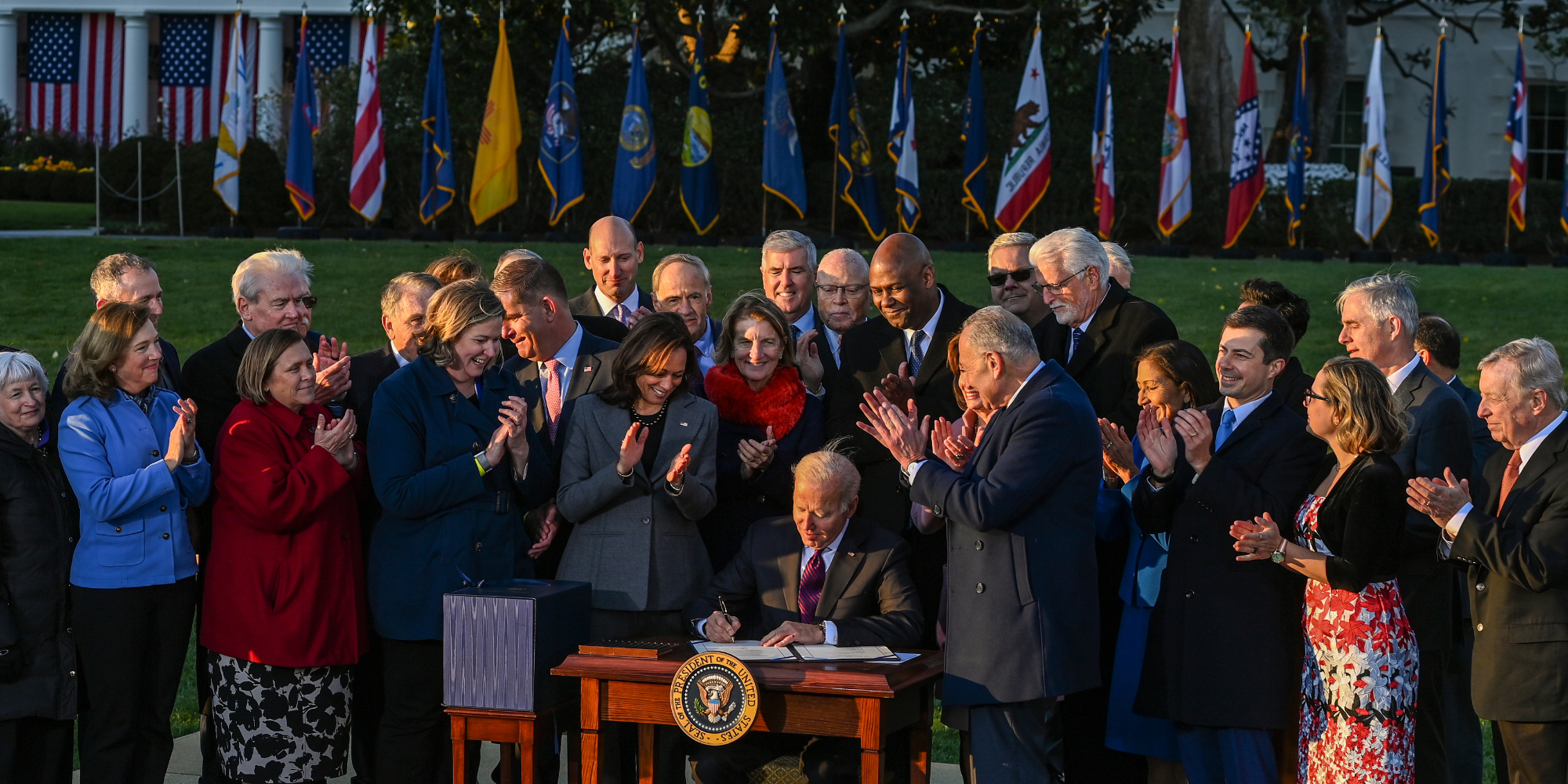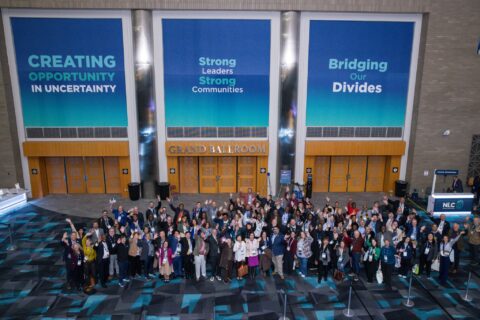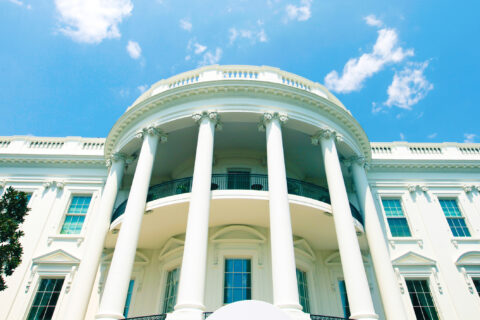Last November, local leaders stood beside President Biden as he signed the Infrastructure Investment and Jobs Act into law. Known as the Bipartisan Infrastructure Law (BIL), this legislation kicked off a five-year race to get federal infrastructure funds out to local communities. Infrastructure has been a top NLC advocacy priority for years, and now a historic investment in transportation, water, broadband, and resilience is available to cities, towns and villages across the country.
For many communities, this is their first time directly accessing federal funds to meet local infrastructure challenges. As we celebrate the one-year anniversary of this major investment in our nation’s infrastructure, we are also looking at how local governments can continue to maximize this opportunity for the next four years.
NLC Delivers for Cities, Towns and Villages
NLC knew local governments were ready to rebuild and strengthen local infrastructure, a difficult task as municipalities also had to deal with recovery from COVID-19, budget and workforce challenges, inflation and more.
In December 2021, we launched our Ready to Rebuild effort to help local leaders find federal infrastructure funding opportunities and educate them on how to apply for funds. We hosted a series of Ready to Rebuild webinars throughout the year on topics from Broadband Help for Your Community to Rolling Out Electric Vehicle Charging in Your Community, where federal partners were able to speak directly to local leaders about the different funding opportunities for their communities.
Over the last year, NLC has produced more than 50 CitiesSpeak blogs and resources on infrastructure specifically for local governments, including:
- Your Infrastructure Questions Answered
- Best Infrastructure Grants for Small Cities
- 10 Ways to Make Your Local Match for Federal Projects
- Program-specific blogs for broadband, lead pipes, energy, rail and bridges
- Briefs on Safe Streets and Electric Vehicle Charging
We conducted a survey with Polco that showed cities, towns and villages are ready to invest in almost every type of infrastructure, with ideas for projects that they’re prepared to implement and complete.
Finally, we launched our largest technical assistance effort yet – the Local Infrastructure Hub – with our philanthropy partners. The Hub offers free training and technical assistance bootcamps for small and mid-sized cities, so that they have access to the resources they need to develop strong applications for federal grants available in the infrastructure law. By bringing together nonprofits, city networks, academics and policy experts, the Local Infrastructure Hub is designed to help participating municipalities produce more competitive federal grant applications now and into the future. Keep an eye out for a new set of bootcamps, which will be launching soon.
The Bipartisan Infrastructure Law is a marathon, and our work is not yet done. Our upcoming City Summit Conference in Kansas City, Missouri includes infrastructure sessions and a whole afternoon dedicated to infrastructure solutions for small cities. Workshops include:
- Safe Streets and Sidewalks for All: Best Practices, Funding Opportunities and More
- Sustainable Infrastructure Investments In a Changing Climate
- Equitable Broadband Expansion in the Face of State Preemptions
- Workforce Development Strategies for the Looming Infrastructure Boom
We hope to see you in Kansas City later this month!

Infrastructure Investments Across the Country
One year in and residents of cities, towns and villages across the nation are already seeing the benefits of the Bipartisan Infrastructure Law in action. Thanks to this investment, cities are making big improvements to their transportation, water, energy and broadband systems.
- Baton Rouge, LA was awarded an INFRA (Infrastructure for Rebuilding America) grant totaling almost $60 million to complete three projects. The first will expand a section of highway and connect local transit, bike and pedestrian networks. The second will add a Bus Rapid Transit (BRT) along a six-mile route, and the third will convert an existing trail into a multimodal pathway for pedestrians and bicyclists.
- An almost $25 million RAISE (Rebuilding America Infrastructure with Sustainability and Equity) grant was award to Duluth, MN to reconstruct approximately two miles of a roadway into an integrated multimodal corridor electric vehicle charging stations, green infrastructure and above-ground streetscape in the Lincoln Park neighborhood. Below ground, the RAISE grant will allow Duluth to replace all underground utilities (water, sewer, stormwater) and add fiber optics for a future broadband corridor.
- Spokane, WA received a $500,000 Brownfields Assessment Grant to conduct eight environmental site assessments and develop four reuse plans and one area-wide plan, and support community engagement activities. The target area for this grant is the Northeast Spokane neighborhood, which contains the abandoned Hillyard Railyard.
- The U.S. Environmental Protection Agency is approving state Intended Use Plans for the five State Revolving Funds for FY22 BIL funding on a rolling basis. Freeport, IL has recently been approved for two loans totaling approximately $29 million to make improvements to its wastewater treatment plant and a sanitary sewer replacement project. A portion of the loan will be awarded as principal forgiveness under the state’s affordability criteria.
Making the Most of this Historic Opportunity
Projects that fulfill the promise of the Bipartisan Infrastructure Law are already underway, but there is still much to do in Washington and at home in cities across the country. Here are three steps local governments can take to make the most of this opportunity:
- Identify programs that meet your local government’s needs and sign up for the corresponding Local Infrastructure Hub bootcamp. Now is the time to ensure your city is picking the programs that address your local concerns. The White House’s BIL guidebook is a great tool to start with. Sign up for updates and information on the latest rounds of Local Infrastructure Hub bootcamps here and look out for other trainings and webinars from federal agencies and NLC.
- Consider your local government’s strategy and partnerships. Work smarter by strategically considering which grants you choose to go after, and how you can collaborate with other partners. For example, the Reconnecting Communities program is relatively small but the RAISE program is larger, so your chances of successfully winning a grant are greater with RAISE. Also, many grants allow for team proposals with local and regional partners, which can give smaller communities support and clarity on how to move forward.
- Ask Congress to help your local government invest in workforce development. The success of our nation’s investments in infrastructure hinge on having a workforce ready to build and maintain that infrastructure. Yet hiring for infrastructure jobs continues to be a significant challenge – the median infrastructure job takes 20 percent more time to fill than a non-infrastructure job. With federal funding for workforce development cut by nearly 40 percent in the last two decades, it is time for Congress to invest in more flexible funding that allows cities to expand their local workforce development initiatives so that the 15 million jobs promised by this historic funding can be filled and usher in an era of expanded infrastructure growth in this country.
Let’s make the most of this historic opportunity to invest in our communities!









